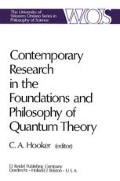Abstract
A very old, yet unresolved problem in physics concerns the basic nature of light. Through the various periods in the history of science, since the days of antiquity, new insights have been gained and earlier concepts rejected. At the present stage of contemporary physics we have learned a great deal about phenomena concerned with the nature of light; still, logical dichotomy and mathematical inconsistency remain in the usual answers to the question: What, precisely, is light? It will be my thesis in this paper that the persistence of these difficulties standing in the way of answering the question satisfactorily have something to do with present-day problems in providing a fundamental description of matter — that, indeed, only a resolution of the problem of matter may lead to a resolution of the problem of light.
Access this chapter
Tax calculation will be finalised at checkout
Purchases are for personal use only
Preview
Unable to display preview. Download preview PDF.
Notes
A bibliography on the classical works in optics is given in the first chapter of the book by M. Jammer, The Conceptual Development of Quantum Mechanics, McGraw-Hill, New York, 1966. Newton’s original researches in optics are reported in his treatise, Opticks, or a Treatise of the Reflexions, Refractions, Inflexions and Colours of Light, S. Smith, London, 1704.
An account of Huygens’ researches is given in his book, Treatise on Light (transi, by S. P. Thompson), Macmillan, London, 1912. Hooke’s researches on the wave theory of light are expounded in his book, Micrographia, 1665.
G. Libri, Histoire des sciences mathématique en Italie, J. Renouard, Paris, 1838-1841, Vol. 3, p. 54 (quoted in Jammer, ibid).
F. M. Grimaldi, Physico-Mathesis de luminie coloribis et iride aliisque adnexis libri duo, Benatii, Bologna, 1665. An extensive discussion of the different approaches to the diffraction phenomenon, including Newton’s explanation, is given in the article by R. H. Stuewer, ISIS 61 (1970), 2, No. 207,188.
A. Fresnel, Annales de Chimie et de Physique 11 (1819), 246, 377. Oeuvres Completes d’Augustin Fresnel’, Imprimerie Imperiale, Paris, 1866.
See, for example, R. C. Tolman, The Principles of Statistical Mechanics, Oxford, 1950, pp. 378, 382.
For a detailed analysis of this point, see the book by P. A. M. Dirac, The Principles of Quantum Mechanics, Oxford, 1958, 4th ed., p. 306.
For further discussion of this logical point, see E. Schrödinger, British Journal for the Philosophy of Science, 3 (1952), 109, 233.
G. N. Lewis, Proceedings for the National Academy of Sciences, (U.S.A.) 12 (1926), 22.
M. Sachs, Il Nuovo Cimento 53B (1968), 398.
M. Sachs, ‘The Electron-Muon Mass Doublet from General Relativity’, Il Nuovo Cimento 78 (1972), 247.
This concept of arbitrary charge of the components of interacting matter, but fixed e2, was discussed in an earlier publication of the author, British Journal for the Philosophy of Science 15 (1964), 213. It is an idea that is also consistent with more recent speculations that nucléons (i.e. neutrons and protons) are composites of constituent fractionally charged particles, that have been called ‘quarks’.
A review of the development of this theory, up to 1972, has recently been published in a series of four papers by the author, International Journal of Theoretical Physics 4 (1971), 433, 453; 5 (1972), 35, 161.
G. N. Lewis, Nature 118 (1926), 874.
M. Sachs and S. L. Schwebel, Supplemento del Nuovo Cimento 21 (1961), 197; M. Sachs, International Journal of Theoretical Physics 1 (1968), 387.
M. Sachs, Il Nuovo Cimento 37 (1965), 977.
Leibniz’ approach is discussed in his essay, Monadology. A translation appears in M. C. Beardsley, The European Philosophers from Descartes to Nietzsche, Modern Library, New York, 1960.
B. Spinoza, Ethics, Hafner, New York, 1960, p. 128.
It seems to me that the first stage, in which man becomes aware of the Universe through the acts of his consciousness, is similar to Buber’s I-it relation. The next stage, where man uses the effects of this awareness as hints in reasoning toward a full understanding of the Universe, in which man is an inseparable component, is an approach toward an understanding similar to Buber’s I-Thou relation. Buber’s philosophy is expressed in his book, l and Thou, Scribner’s, New York, 1958. Further discussion on this point is given by the author in Philosophy and Phenomenological Research 30 (1970), 403.
Maimonides’ major philosophical work is his treatise, The Guide of the Perplexed (transi, by S. Pines), University of Chicago Press, Chicago, 1963.
Cresas’ philosophical ideas are expressed in his book, Or Ad-o-nai. Part of this work is translated in the book by H. A. Wolfson, Cresas’ Critique of Aristotle, Harvard University Press, 1929.
Author information
Authors and Affiliations
Editor information
Editors and Affiliations
Rights and permissions
Copyright information
© 1973 D. Reidel Publishing Company, Dordrecht, Holland
About this chapter
Cite this chapter
Sachs, M. (1973). On the Nature of Light and the Problem of Matter. In: Hooker, C.A. (eds) Contemporary Research in the Foundations and Philosophy of Quantum Theory. The University of Western Ontario Series in Philosophy of Science, vol 2. Springer, Dordrecht. https://doi.org/10.1007/978-94-010-2534-8_9
Download citation
DOI: https://doi.org/10.1007/978-94-010-2534-8_9
Publisher Name: Springer, Dordrecht
Print ISBN: 978-90-277-0338-5
Online ISBN: 978-94-010-2534-8
eBook Packages: Springer Book Archive

